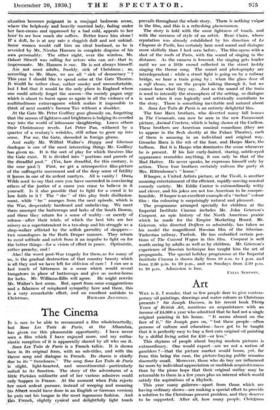The Cinema
IT is rare to be able to recommend a film wholeheartedly, but Sous Les Toils de Paris, at the Alhambra, has given me this pleasurable opportunity. I have never seen a film which I have enjoyed more, and my enthu- siastic reception of it is apparently shared by all who see it.
Sous Les Toils de Paris is a French talkie. It is shown here in its original form, with no sub-titles, and with the 'theme song and dialogue in French. Its charm is chiefly dud to its " frenchness." The song Sous Les Toils de Paris 1S` slight, light-hearted, and unsentimental—particularly suited to its function. The story of the adventures of a little Parisian midinette and of her various admirers could 'only •happen in France. At the moment when Pola rejects her most ardent pursuer, instead of weeping and moaning ''(as Albert would have done in an English or German version) he puts out his tongue in the most ingenuous fashion. And, this French, slightly cynical and delightfully light touch
prevails throughout the whole story. There is nothing vulgar in the film, and this is a refreshing phenomenon.
The story is told with the same lightness of touch, and with the sureness of style of an artist. Rene Claire, whose reputation was already established by his direction of Le Chapeau de Paille, has certainly here used sound and dialogue more skilfully than I had seen before. The film opens with a shot of the roofs of Paris, with the sound of singing in the distance. As the camera is lowered, the singing gets louder until we see a little crowd collected in the street lustily singing the theme song. The sound and photography arc interdependent : while a street fight is going on by a railway bridge, we hear a train going by ; when the glass door of a café closes, we see the people talking through it, but we cannot hear what they say. Just as the sound of the train is used to intensify the atmosphere of the setting, so dialogue is used when it can logically and artistically contribute to the story. There is something inevitable and natural about it. Sous Les Toils de Paris is an entirely delightful film.
The four Marx brothers, who diverted many full houses in The Cocoanuts, can now be seen in the new Paramount picture, Animal Crackers, which is being shown at the Carlton. These brothers are American musical comedians (they are to appear in the flesh shortly at the Palace Theatre), each of them is amusing in an individual and original way. Groucho Marx is the wit of the four, and Harpo Marx, the buffoon. But it is Harpo who dominates the scene whenever he is present. If his fair curly-haired, staring, subtle-eyed appearance resembles anything, it can only be that of the Mad Hatter. He never speaks, he expresses himself only by action. These four brothers certainly enliven the party at Mrs. Rittenhouse's " home."
Whoopee, a United Artists picture, at the Tivoli, is another amusing entertainment of the efficient, rapidly-moving musical comedy variety. Mr. Eddie Cantor is extraordinarily witty and clever, and his jokes are not too American to be compre- hensible. Whoopee is an excellent example of a " techni" colour film : the colouring is surprisingly natural and pleasant.
The programme arranged specially for children at the Imperial Institute Cinema includes Mr. John Grierson's Conquest, an epic history of the North American prairie which he made for the Empire Marketing Board. Mr. Grierson, who directed Drifters so admirably, has taken as his model the magnificent Russian film of the Siberian- Turkestan railway, Turksib. He has embodied certain por- tions of The Covered Wagon in this film. Conquest is well worth seeing by adults as well as by children. Mr. Grierson's experience of Russian technique has taught hint the art of propaganda. The special holiday programme at the Imperial Institute Cinema is shown daily from 10 a.m. to 1 p.m. and from 2.30 p.m. to 10 p.m., and on Sundays from 2.30 p.m. to 10 p.m. Admission is free.
CELIA SIMPSON.






































 Previous page
Previous page